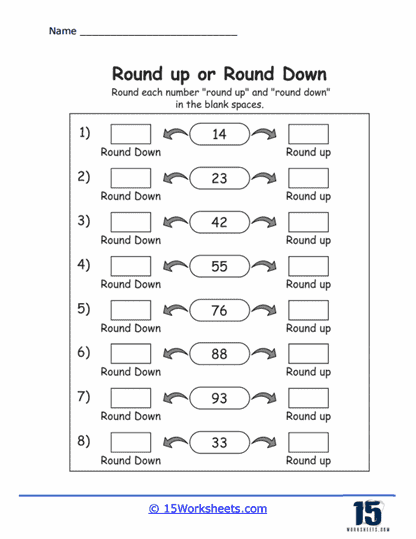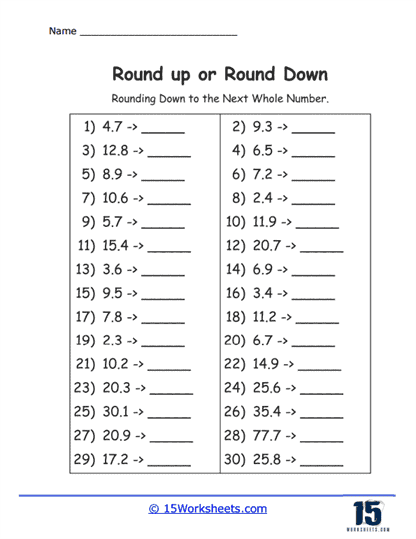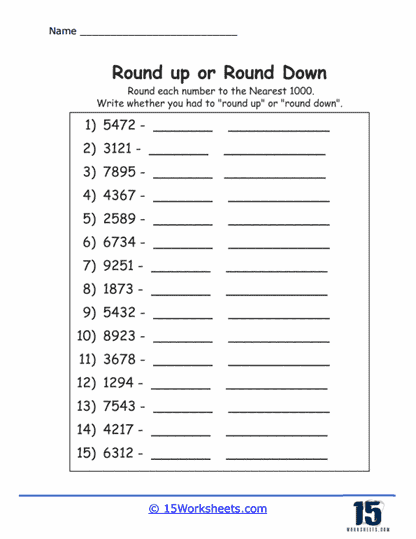Round Up or Down Worksheets
About These 15 Worksheets
These worksheets will help students the skill of rounding numbers to the nearest place value, whether it be whole numbers, hundredths, tens, or multiples of five. Each worksheet presents a range of numbers, and students are tasked with determining whether to round the number up or down based on the digits they are given. The skill of rounding is foundational for estimation, mental math, and simplifying calculations, and these worksheets provide an engaging way for students to practice.
A common feature across these worksheets is a clear emphasis on numbers that are just above or below certain thresholds, such as halfway points. For example, when rounding to the nearest whole number, students learn to look at the digit immediately after the target place value. If the digit is 5 or greater, they round up; if it is less than 5, they round down. This basic principle is repeated across different rounding concepts, and students apply this logic to numbers with decimals, larger values, and even rounding to specific multiples like 5 or 10. By continually practicing this, students solidify their understanding of how numbers behave in different contexts.
In some worksheets, students focus on rounding to the nearest hundredth, which involves more precise number sense. Here, the task becomes more challenging as they work with decimal points, requiring them to consider the value of the digits in the thousandths place to determine whether to round up or down. This builds precision in their mathematical skills, especially when dealing with more complex operations like measurements or calculations involving money.
Other worksheets dive into rounding up to the nearest multiple of five, which introduces the concept of rounding within a number system that isn’t based on powers of ten. In this case, students are tasked with deciding how close numbers are to multiples of 5, requiring them to think about grouping and patterns within the number system. This is particularly useful for real-world applications, such as rounding to the nearest nickel in monetary transactions or estimating quantities in groups of five.
This collection of worksheets emphasize rounding numbers to the nearest ten or hundred focus on larger-scale estimation, teaching students how to simplify more complex numbers for faster mental math. These worksheets typically ask students to evaluate numbers and round them up or down to either 50, 100, or even 1,000. The purpose here is to prepare students for real-life scenarios where they might need to estimate costs, distances, or quantities quickly without the need for exact calculations. The ability to round large numbers efficiently is a critical skill that helps students transition into more advanced math concepts.
In addition to individual numbers, some worksheets require students to evaluate lists of numbers, determining whether to round each up or down based on specific criteria. This repetition strengthens the students’ confidence and consistency in rounding, as they learn to make quick decisions by following a straightforward rule. They also get the opportunity to compare their answers, reinforcing the concept that numbers behave predictably when rounded according to the same rules. This practice enhances their problem-solving speed and accuracy.
The final category of worksheets offers opportunities for students to engage with rounding in a slightly more abstract way by using comparative questions. These activities ask students to determine whether a number is closer to one value or another. This type of rounding exercise challenges them to think beyond just following rules and to start making more intuitive judgments about number proximity. In these exercises, students often find themselves considering which values are “closer” based on their understanding of numerical distance, which is a great way to deepen their conceptual understanding of the rounding process.
In all these exercises, students are asked not only to round numbers but to explicitly state whether they rounded up or down. This reflection on the process helps to reinforce their understanding of the underlying concept, as it makes them aware of their thought process. By engaging with the activity in this way, students become more thoughtful and deliberate in their calculations. This also helps to correct common misconceptions, as students who are asked to justify their answers can better recognize and learn from their mistakes.
By introducing students to different rounding rules and gradually increasing the complexity, these worksheets ensure that students develop a strong number sense. Whether they are rounding decimals, larger numbers, or even working with multiples, students come away from these exercises with a deeper understanding of how to simplify numbers for quick mental math. Rounding is not just a standalone skill-it is one that they will carry with them through their entire mathematical journey, from basic arithmetic to more complex algebra and geometry.















